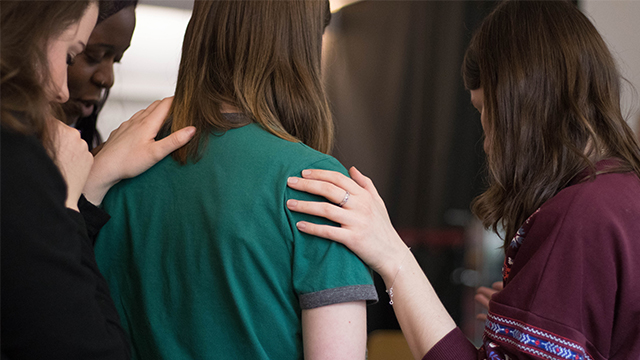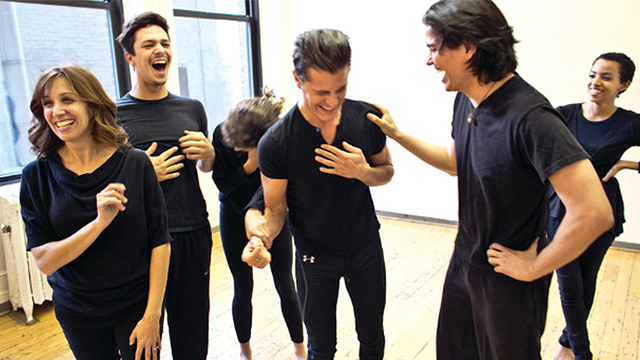5 of the Best Activities for a New Acting Class
Written by Ryan Howland
September 25, 2019
It’s the start of the school year, and we know that Drama teachers all across the country are looking for creative ways to introduce themselves, establish a community feel in their class, and set the tone for classroom expectations for the rest of the year. The first week of school can set the tone for any school year, so here are some of the best activities to start your Drama classes off right.
Hopes and Fears

This activity is a good way to get students looking towards the future, start making goals for Drama class, and get them on their feet and acting right away! It is also a good way to assess students’ comfort level with being in a Drama class.
Break students into groups of 3 or 4 and give each group two pieces of paper. On one piece of paper, have them brainstorm their hopes for the coming school year. Maybe it is a goal they have, a lesson they really want to learn, or friends they are hoping to make. On the other piece of paper, have them brainstorm their fears for the school year. Are they nervous about performing in front of others? Anxiety about finding a seat in the cafeteria? A class they’re not looking forward to?
Once they have their two lists, have each group choose one hope and one fear which they will bring to life in a short scene. They can do two separate scenes, or they can combine their hope and fear together into one scene.
Group Juggling

This activity is a good name game and an excellent way to build ensemble among your class. You will different several different colored balls or objects that can be tossed. Stand in a circle with your class and start with your first ball. Pass the ball to someone across the circle from you and say their name. They will pass the ball to another person in the circle while saying their name. Keep going until everyone has received the ball.
Now take a second ball and toss it to someone across the circle while saying your favorite color. They will do the same to another person and so on until everyone has received the ball.
Now do both those passes as the same time, using the same people you passed the ball to before. Voila, group juggling! You can add as many balls you want, or as many balls as your group can handle. You can use favorite food, favorite location to travel to, favorite Broadway musical, etc.
Build Your Dream Theatre

This activity is great when working with students who are a little uncomfortable performing in front of others, and are new to theatre. Start by giving the students pieces of paper and markers and telling them to draw the theatre of their dreams, or the theatre that would make them the most comfortable to perform on. For instance, if they really love sports, maybe they turn their stage into a gymnasium!
Once they’ve finished their drawing, have them take a piece of cardstock paper and fold it in half to make a “stage.” Then, give them a list of specific parts of the theatre (proscenium arch, wings, fly space, trapdoor, etc.). Using craft materials, tell them to build the theatre of their dreams, while also including all the parts of the theatre listed. You will get some really cool results!
Create (and act out!) a Drama Class Respect Agreement

Respect Agreements are a great way to establish class expectations and have students feel like they have a bearing on the classroom environment. Have students brainstorm how they would like to treat you (student to teacher), how they would like you to treat them (teacher to student), how they would like to treat each other (student to student), and how they would like to treat the space (everyone to the drama room). Split into four different groups, and have them act out an expectation from each category. You can even have them act out what would happen if they were to violate one of these expectations!
World’s Worst Auditions

This game is a tried and true classic, and a good way to get students performing right away without any pressure. Give students sides (open scenes might be a great idea!), and have one student be the “auditioner” and one student be the “reader.” The reader reads their lines with no inflection, and the auditioner purposefully puts on a “bad” performance. Maybe they’re too quiet, too loud, too fidgety, etc. Have every student try something new each time they “audition.”
Need some advice? We’ve got you covered.
- 10 Tips for Being a Positive Role Model in Your Theatre Community
- 5 Ways to Say “Thank You” to Your Cast and Crew
- 5 Character Development Techniques to Use in Rehearsals
- 5 Small Ways to Get Into (And Embrace) Your Character
- 5 Ways to Take Care of Yourself During Tech Week
- Devising Theatre: 7 Quick Tips for Your First Devising Project
- “I Can’t, I Have Rehearsal”: 5 Tips for Scheduling Your Life When You’re In Theatre
- How to Make Rehearsals A Warm and Welcoming Environment
- 10 Basic Rules of Stage Combat (That Keep Everyone Safe)
- 5 Advantages of Learning Stage Combat
- Theatre Artists on a Budget: How to Be Smart and Healthy While Pinching Pennies
- Productions on a Budget: Finding Props/Costumes/Set Dressings/Set Pieces Without Breaking the Bank
- 6 Steps to Memorizing Shakespeare
- 5 Helpful Tips for Attending Callbacks
- 10 Tricks to Staying Healthy All Season Long
- How to Balance Theatre and Coursework
- 10 Items Every Actor Should Carry in Their Rehearsal Bag
- 10 Items Every Dancer Should Keep in Their Rehearsal Bag
- Discover the Delightfully Nerdy World of Dramaturgy
